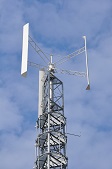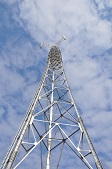The presented system performs two basic functions:
• In the field of energy management
- in terms of autonomous operation of the metamast GETS (off-grid) - the system monitors and to the possible extent manages the operation of the elements of the mast, i.e. wind turbine (monitoring), neodymium power generator with permanent magnets (monitoring and management), backup combustion generator (monitoring and management ) and energy storage (monitoring and management).
- in terms of the operation of the metamast GETS connected to the grid (on-grid) - the system performs functions identical with the functions of off-grid metamast and additionally manages the dynamic connecting/disconnecting of the metamast from/to the grid. The decision to connect/disconnect the mast GETS is taken on the basis of internal factors (such as the level of power generated by wind turbine, level of fuel in a combustion generator, level of energy storage, etc.) and on the basis of external factors, in terms of the National Power System, provided by TSO (PSE) operator or DNO operator.
• In the field of access control and fire protection
– the system centrally manages access control in all connected metamasts GETS and monitors the current status of fire protection. In case of need for the service in a given metamast, the technical services are centrally dispatched.
Advantages of the metamast GETS versus standard wind
• vertical axis of rotation of the rotor - work independent of wind direction - no need to use the mechanism "set according to the wind direction", quiet operation - even at maximum rotation speed, resistance to strong wind, resistance to hard rime, frost and sticky snow (no danger to humans and animals, associated with the risk of separating the fragments from the blades of a wind turbine), little impact on the environment.
• stabilization of power generated from RES source –the proposed form of the metamast GETS combines the advantages of RES (in terms of sustainability of energy) and the advantages of a conventional source (in terms of high stability of such a system).
• the positive impact of the metamast GETS on the distribution network of DSO operator - renewable energy sources RES, due to their instability of generation have almost always negative impact on the distribution network of DSO operator. The metamast GETS, owing to the stability of operation, does not produce such effects, and what is more – due to the possibility to give back and acquire energy to/from the network, it has a positive effect on the balancing of the local balancing area and adjusting the frequency of the network operation within this area.
• emergency power supply in case of separating island area – the metamast GETS can operate both in on-grid and off-grid systems. In the case of separation from the network not only of the metamast GETS, but the entire branch of distribution network to island work, the sources of energy will supply not only the load of the metamast GETS, but also to all recipients connected to a separate energy island.






